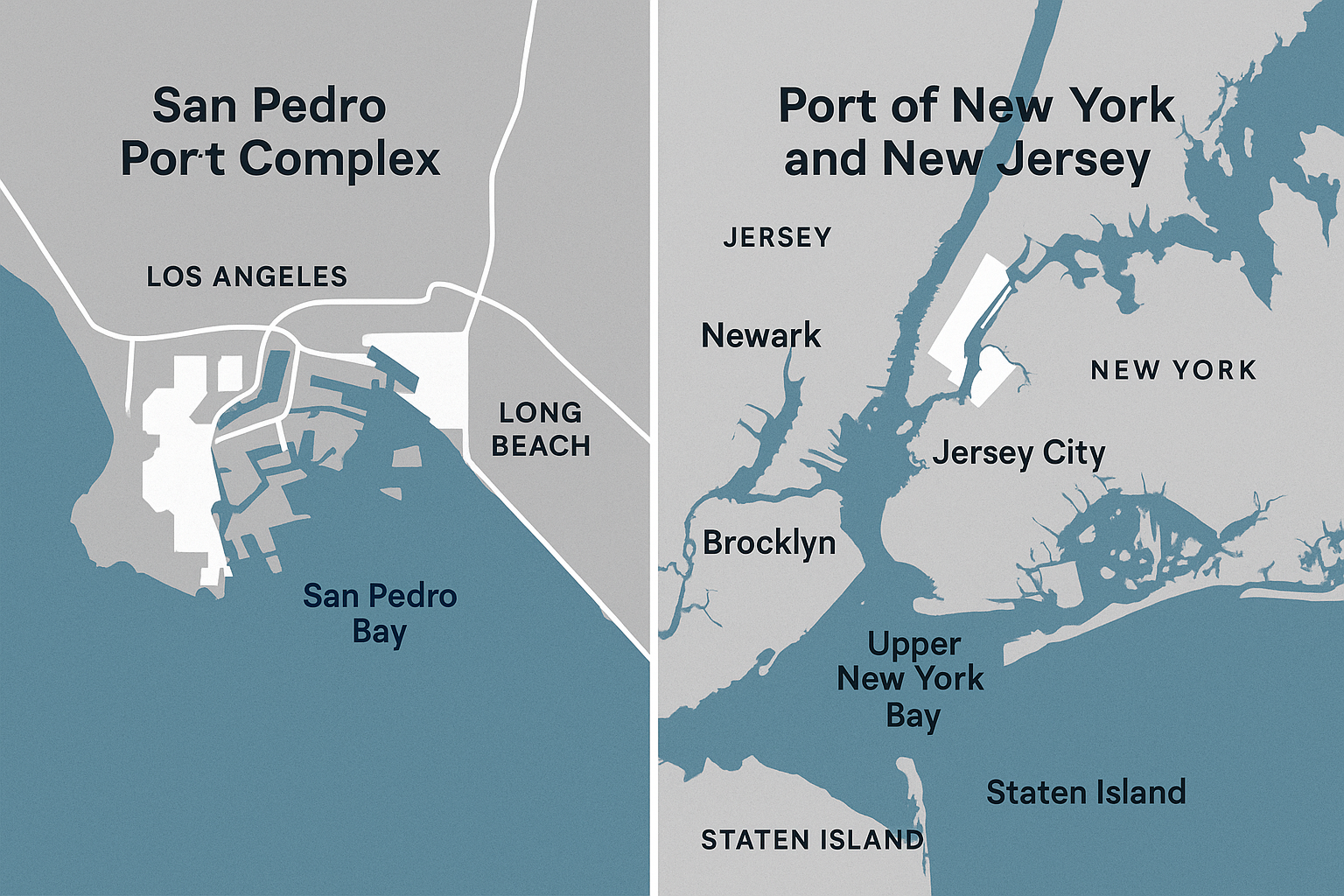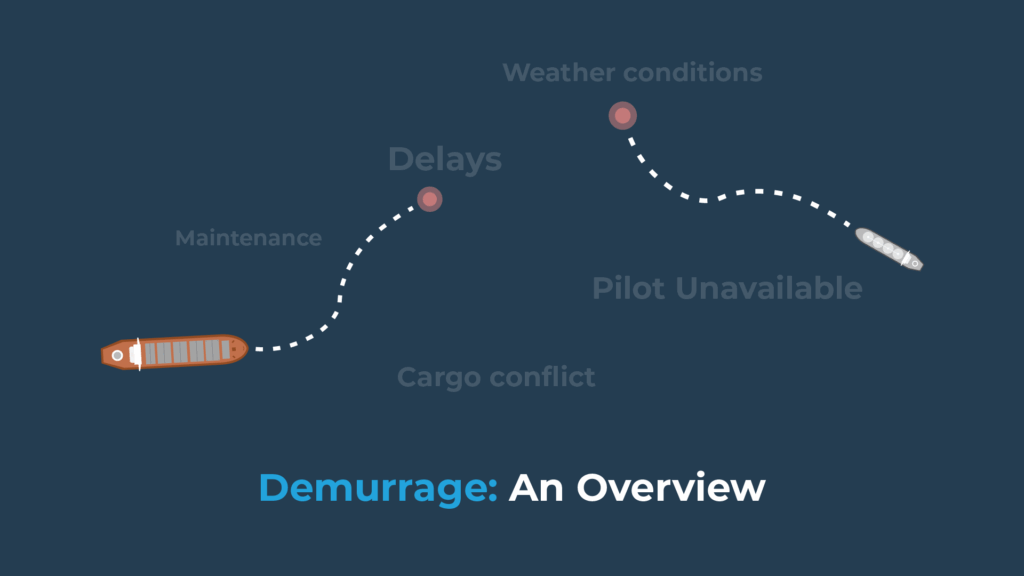In the ever-competitive world of global logistics, the San Pedro Bay Port Complex vs NY NJ Port Complex debate reflects the evolving face of American maritime dominance. One represents the Pacific gateway to Asia; the other is the Atlantic bridge to Europe. Each has strengths—and each faces challenges. This article delivers a clear, comparative look at both.
1. What Is the San Pedro Bay Port Complex?
The San Pedro Bay Port Complex includes two major ports:
🟢Port of Los Angeles
🟢Port of Long Beach
Together, they:
- Span over 7,500 acres
- Handle more than 18 million TEUs annually
- Represent nearly 31% of all U.S. containerized international trade
This port complex is the largest in the Western Hemisphere, vital to imports from China, Japan, Korea, and Southeast Asia. Its strategic location on the Pacific makes it the preferred entry point for Asian goods bound for the U.S.

2. What Is the NY & NJ Port Complex?
The Port of New York and New Jersey serves as the largest seaport on the U.S. East Coast. It includes major terminals such as:
- Port Newark-Elizabeth Marine Terminal
- Port Jersey
- Red Hook Terminal
✅Key stats:
- Over 7.8 million TEUs handled in 2023
- Serves more than 100 million people within 250 miles
- Major gateway for goods from Europe, South America, and Africa
Its prime location and access to dense populations give it a competitive edge in distribution speed and last-mile logistics.
3. Transportation Infrastructure Breakdown
🟢San Pedro Bay:
- Intermodal rail: On-dock rail capabilities reduce truck congestion
- Alameda Corridor: 20-mile freight expressway links directly to major inland hubs
- Freeway access: I-710, I-110, and I-405 facilitate truck routes
🟢NY & NJ Port Complex:
- ExpressRail system: Moves 20%+ of all cargo via rail
- Air proximity: Near JFK, EWR, and LGA airports for integrated logistics
- Turnpike access: Direct connections to I-95 and I-78 for East Coast distribution
📌30%+ of these port operations relate directly to transportation, a critical logistics layer for both shippers and receivers.
4. Trade Flow Patterns
| Trade Aspect | San Pedro Bay | NY & NJ Port Complex |
|---|---|---|
| Primary Import Region | Asia (China, Japan, South Korea) | Europe (Germany, UK, Netherlands) |
| Export Focus | Agricultural goods, auto parts | Pharmaceuticals, consumer goods |
| Seasonal Surge | Peak in late Q3 for holiday shipments | Strong year-round volume distribution |
The San Pedro Bay Port Complex vs NY NJ Port Complex battle often shifts based on trade policy, labor negotiations, and infrastructure capacity. East Coast ports gained ground during 2022–2023 when West Coast ILWU contract talks caused diversions.
5. Recent Disruptions and Developments
- Trump Tariffs 2025: Aggressive tariff hikes (up to 145%) affected over 30% of cargo through LA/LB, disrupting schedules and diverting shipments to East Coast ports
- Eco Initiatives: San Pedro Bay ports launched near-zero emission cargo handling equipment
- NY/NJ Modernization: Recent dredging and automation upgrades increased vessel capacity and reduced berthing delays

6. Performance Metrics
| Metric | San Pedro Bay | NY & NJ Port Complex |
|---|---|---|
| Annual TEUs | ~18 million | ~8 million |
| Truck Dwell Time | 3.1 days | ~2.7 days |
| Rail Dwell Time | 6.5 days | ~5.3 days |
| On-Time Vessel Rate | 85% | 89% |
| Emissions Score | A (green initiative leader) | B+ (rapid improvement underway) |
7. Economic Impact Comparison
🟢San Pedro Bay Port Complex:
- Supports 2.7 million U.S. jobs
- Generates $276 billion in economic value
- Crucial for retail and e-commerce giants on the West Coast
🟢Port of NY & NJ:
- Supports 500,000 regional jobs
- Adds $25 billion+ in local economic output
- Major hub for time-sensitive pharmaceuticals and perishables
8. Future Outlook: Who Will Dominate?
- West Coast: Still preferred for high-volume Asian freight; needs continued investment in efficiency and resilience
- East Coast: Gaining edge in agility, diversification, and congestion avoidance
Prediction: Both port complexes will remain dominant—but NY & NJ may increasingly rival San Pedro Bay as trade flows diversify and East Coast consumer markets expand.
Request a Quote
Need a tailored solution for your shipping from China?
Let TJ China Freight Forwarder assist you with reliable, cost-effective service.
FAQ:
Q1.Which port is better for importing from China?
San Pedro Bay is faster and cheaper for direct Asia–U.S. routes.
Q2. Does the NY/NJ port handle oversized cargo well?
Yes, especially via Port Newark with special project cargo zones.
Q3.Is congestion worse at LA or NY ports?
San Pedro Bay faced severe congestion during 2021–2022 but improved in 2024. NY/NJ has better dwell times recently.
Q4.Are both ports suitable for Amazon FBA?
Yes. San Pedro Bay is closer to West Coast FBA centers; NY/NJ benefits East Coast distribution.
Q5.How do rail connections compare?
Both have strong intermodal rail systems. San Pedro Bay benefits from the Alameda Corridor; NY/NJ boasts ExpressRail.
